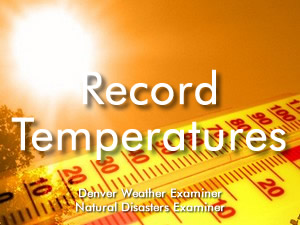
Triple digit heat broiled the northeastern United States on Tuesday while record setting cool weather struck southern California. Denver may be next to see cool temperatures for the record books as the United States experiencing a wide variety of temperatures.
On the East Coast, temperatures exceeding 100 degrees struck from Virginia north to Massachusetts. Many of the temperatures recorded set new high temperature records for the date including:
- Allentown, PA – 101 degrees (old record 100 degrees set in 1999)
- Atlantic City, NJ – 102 degrees (old record 99 degrees set in 1999)
- Baltimore, MD – 105 degrees (old record 101 degrees set in 1999)
- Newark, NJ – 103 degrees (old record 102 degrees set in 1999)
- New York City, NY (Central Park) – 103 degrees (old record 101 degrees set in 1999)
- Philadelphia, PA – 102 degrees (old record 98 degrees set in 1999)
- Warwick, RI – 102 degrees (old record 97 degrees set in 1999)
- Wilmington, DE – 103 degrees (old record 98 degrees set in 1999)
- Windsor Locks, CT – 102 degrees (old record 99 degrees set in 1999)
On the opposite coast of the nation, record low maximum temperatures were recorded from San Diego up to Riverside. Low pressure and a thick marine layer of clouds held temperatures down and residents that would normally be wearing shorts and tank tops traded that clothing for jeans and sweatshirts.
Among the tied or broken record low maximums recorded in southern California on Tuesday were:
- Escondido – 69 degrees (old record 78 set in 1987)
- Laguna Beach – 62 degrees (old record 68 set in 1968)
- Newport Beach – 66 degrees (tied record of 66 last set in 1995)
- Oceanside Harbor – 62 degrees (old record 65 set in 2002)
- Riverside – 79 degrees (old record 80 set in 1969)
- San Diego – 65 degrees (tied record of 65 last set in 1912)
On Wednesday, both the northeastern United States and southern California may see those record-setting temperature trends continue.
Denver also stands a chance to see a record setting low maximum today. The forecast for Denver International Airport where Denver’s official temperature measurements are now taken is for a high of 63 degrees today. The current record low maximum is 65 degrees last set in 1952. Here in Thornton we will see similar temperatures.



 Get the rest of this story including more photos and video explaining the phenomena at the Denver Weather Examiner!
Get the rest of this story including more photos and video explaining the phenomena at the Denver Weather Examiner!





